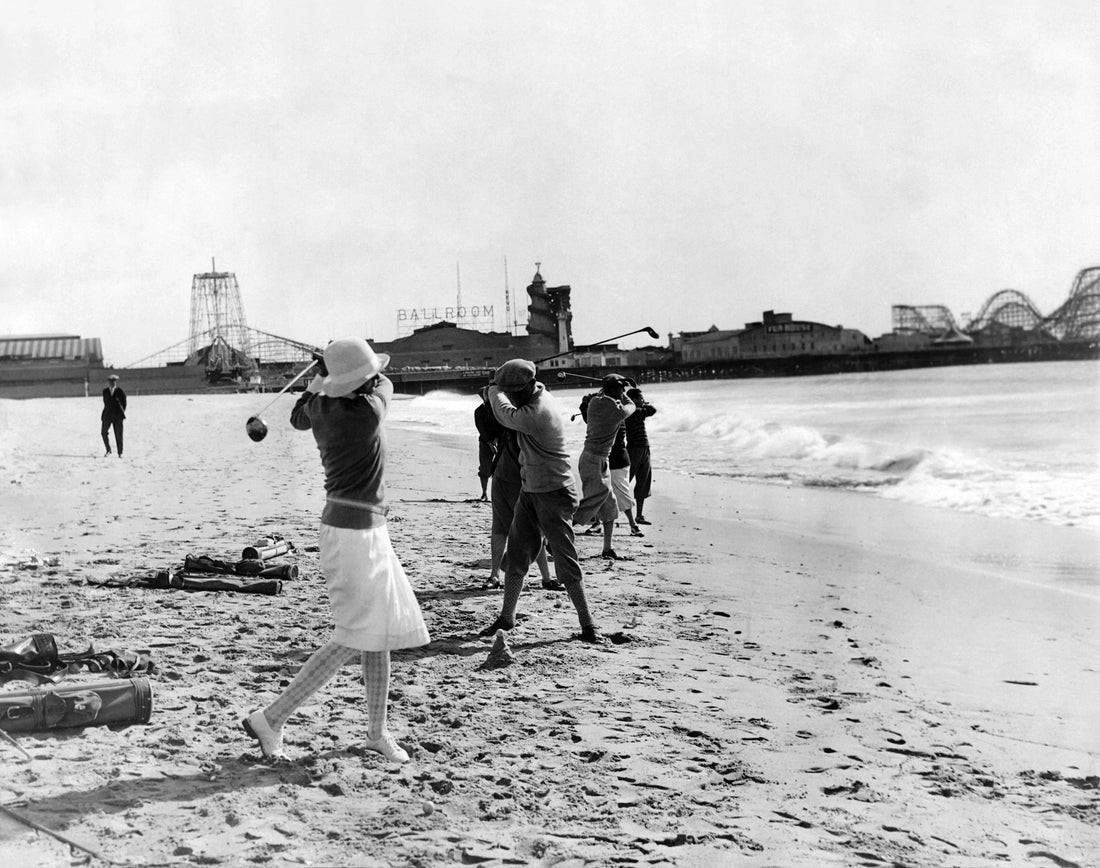
History Of Golf: Where Was Golf Invented?
You may know about today’s golf equipment and the top players in the world, but how much do you know about the history of golf? This game has been played for hundreds of years by players across the world.
Below we explore the game’s humble beginnings through the present day. What started as a niche hobby has grown into an 80+ billion-dollar business. The history of golf is truly an amazing story.
How did we get to 350+ yard drives and 7,500-yard golf courses? How much has golf equipment changed? What would you shoot using gear from the 1800s? You can find all of these answers and more in the history of golf.
Where Was Golf Invented?
Let’s start our historical investigation of golf with a location. Where was golf first played? While some of the facts are disputed about the beginning of the game, it’s widely accepted that the game of golf started in Scotland during the 15th century.
The early history of golf has many interesting twists and turns. At first, the game was played by hitting pebbles over or around sand dunes with bent sticks. It quickly became popular and even drew attention from the Scottish government. In the 1450s, the game was banned by King James II’s parliament because young men were playing instead of completing their military training.
The game gained the royal seal of approval shortly after 1500 when King James IV took up golf. During the 16th century, golf started to spread across Europe and by the 1700s the game started to resemble what we play today. The first “rules of golf” were established in 1744 and the first 18-hole golf course was constructed in 1764.
Where Did The Term ‘Golf’ Come From?
You can find several different explanations for the term “golf,” but we can promise it has nothing to do with the old joke that all other 4-letter words were taken.
For the history of golf, we trust the USGA (United States Golf Association), so we’ll go with their explanation of the etymology: “It derives linguistically from the Dutch word 'kolf' or 'kolve,' meaning quite simply 'club.' In the Scottish dialect of the late 14th or early 15th century, the Dutch term became 'goff' or 'gouff,' and only later in the 16th-century golf.'”
There was a very active trade industry between Dutch ports and ports on the east coast of Scotland during the time that golf was invented. It’s quite possible that Dutch sailors played a role in the creation and history of golf.
Early Golf Equipment
Next up, let’s take a closer look at how golf gear has changed over the last 600 years. You can’t talk about the history of golf without considering the changes in equipment.
History Of Golf: Golf Clubs
The first golfers used sticks to hit stones and pebbles, but quickly players started to build or purchase clubs. In the early 1500s, King James IV of Scotland had a set of clubs made and even appointed a person to the title of “Royal Club Maker.”

Due to the lack of a uniform construction model, golf clubs were often very different depending on who built them. It wasn’t until the 19th century that the concept of forging irons started to produce higher-quality products. Handmade wooden “woods” were typical during this time and golf professionals were often better known for their club making than their ability to play the game.
For hundreds of years, all golf clubs were made with wooden shafts (hickory was determined to be the best option). Shafts made from metal weren’t introduced until the early 1900s and weren’t considered legal for competition until 1929.
It wasn’t until the 1970s that we started to see golf companies invest in new technologies that would change how the game is played. It was during this time that the first graphite shaft was created and PING invented cavity-back irons.
TaylorMade was the first golf manufacturer to produce “woods” made from metal, but Callaway scored big with their Big Bertha driver in 1991. The final major evolution for golf clubs was the release of “hybrids” in the early 2000s. This new type of club replaced longer irons (3-iron, 2-iron, 1-iron).
Golf companies continue to innovate, looking for ways to give golfers more distance and accuracy. The USGA (United States Golf Association) and the R&A now have guidelines in place to determine if new clubs are legal or illegal.
History Of Golf: Golf Balls
Similar to golf clubs, the balls we use to play have changed drastically since players smacked pebbles along the east coast of Scotland. The first balls were made from wood and it’s hard to imagine how you get this type of ball to fly straight. They were made from hardwoods (Beech, Boxroot, etc.) and the performance would change drastically with each shot.

Source: The Red Shirts Golf Club
In the early 1600s, players started to gravitate to a “feathery” golf ball. These were built by stuffing leather with boiled goose feathers. They were difficult to make and expensive. This type of golf ball wouldn’t last very long and if it got wet, it’d quickly fall apart. Even so, it was the standard type of ball used until the mid-1800s.
In 1848 Dr. Robert Adams created the “Gutty” ball. The Gutty golf ball was created from the dried sap of the Sapodilla tree. It had a rubber-like feel and was easier to make than its predecessor. It was inexpensive compared to the “feathery” and made the game of golf accessible to the masses.

Source: Scottish Golf History
The “Gutty” helped grow the game of golf for 50 years until the invention of the rubber-core golf ball. This was the beginning of the modern-day golf ball. Over the last 100+ years, golf ball engineers have improved performance with dimples, stronger materials, and more consistent construction methods.
Most golfers would say the last major golf ball innovation was the release of the Titleist Pro V1 in 2000. This created a durable and long golf ball that was soft around the green. It continues to be the most popular ball on professional tours around the world.
History of Golf: Golf Tees
It seems like a small piece of equipment, but the golf tee plays an interesting role in the history of golf. From the very beginning of the game, players would use wet sand to build a small mound to get their ball off the ground and help them get tee shots up in the air. Early golf courses placed a small box of sand next to the “tee box” to help players construct their tees.

Source: Patent Artwork
Over the years golfers tried different types of tees, but the USGA recognizes inventor Dr. George Grant as the first person to design and patent the wooden golf tee. This was in 1899. In 1922, Dr. William Lowell patented and marketed his “Reddy Tee” which is the foundation for the modern-day version.
History of Golf: Golf Bags
The golf bag has a shorter history than most other equipment. For the first 300-400 years of golf players simply carried their clubs as they walked the course. It was popular to wrap them in twine to keep them together.
It wasn’t until the late 1800s that golf bags started to be used. These were very basic “pencil” golf bags. Typically they were made from canvas and were about 4 inches in diameter. It wasn’t until the golf carts started to be used that changes started to be made to golf bags.
Golf bags started to grow in size, with increased storage and pockets. Golfers could choose from different materials such as leather or cloth. Unfortunately, these golf bags were nearing impossible to carry if you wanted to walk the course.
In 1986, Sun Mountain introduced the first lightweight carry bag that included a tripod stand to keep the player’s clubs off the ground. This was the beginning of the golf bags we use today. Innovations have been made to help the walking golfer. The most significant is the double-shoulder strap.
Today you can choose from several different types of bags. A cart bag if you typically ride in a cart. A carry bag if you want to walk and a Sunday bag for casual rounds. A Sunday bag most resembles the original bags of the 1800s.
History of Golf: Golf Clothing
Golfers have always had a unique style while playing the game, but it certainly has changed over the years. The first players picked their clothing to handle the elements of Scotland. They wore thick fabrics such as tweed to protect them from harsh conditions.
The most iconic piece of golf clothing has to be the knickers with high socks. This fad started in the early 19th century and carried on for over a hundred years. In the early 1900s, golfers were expected to dress quite formally. The typical attire would include a single-breasted jacket, waistcoat, patterned long socks, two-tone shoes, shirts and ties, and knitted cardigans.

As the game became more popular during the middle of the 20th century, golf clothing started to be more casual. Dress codes were established at most clubs, but you simply needed khaki pants and a collared golf shirt. Playing in jackets and ties became a thing of the past.
While some dress codes are still in place, modern-day golf fashion has continued to become less formal. Golf clothing is designed to help the athlete perform and handle the elements (heat, rain, etc.). We have come a long way from tweed jackets and knickers.
History Of Golf: Golf Tournaments
We’re fairly certain the first golfers enjoyed competing against each other on the Scottish coast, but golf tournaments as we now define them are a recent addition to the history of golf. For the first 250 years the game was played, there were no official rules. In order to hold a competition (tournament) in 1774, the first “rules of golf” were drafted by the Gentlemen Golfers of Leith.
The oldest major championship is the British Open (The Open Championship) and it was first played in 1860. In 1864, the USGA (United States Golf Association) was formed to standardize the rules and manage tournaments for amateurs and professionals. Eleven players competed in the first U.S. Open in 1895.
While there were events held prior, the types of golf tournaments that we see today didn’t start until the 20th century. The first PGA Championship was played in 1916 and the Masters didn’t start until 1934. The PGA Tour, LPGA Tour, and the European Tour are all less than 100 years old.
History Of Golf Timeline: Infographic

What’s Next? What Should We Expect In The Future of Golf?
We’ve revisited the history of golf, but what do you see in the future of the game? We expect to see the following over the next 50 years.
The technology of the game (equipment and balls) will continue to improve and the USGA will try to govern to protect the integrity of the game. We won’t see bigger drivers than we have today.
Professional golfers will continue to amaze us with their skills. Tiger started the trend of golf fitness, and we’ve seen more athletes gravitate towards the game. They’ll continue to get bigger, stronger, and longer.
The game will continue to grow in popularity and we’ll see more ways to enjoy the game. More par 3 courses, more high-tech driving ranges (Top Golf), and more programs to get kids involved in golf.
Regardless of the changes we see in the future, golf will continue to be a game you can enjoy for your entire life. It’ll always be a great way to get outside, to spend time with friends/family, and to get a little exercise.
